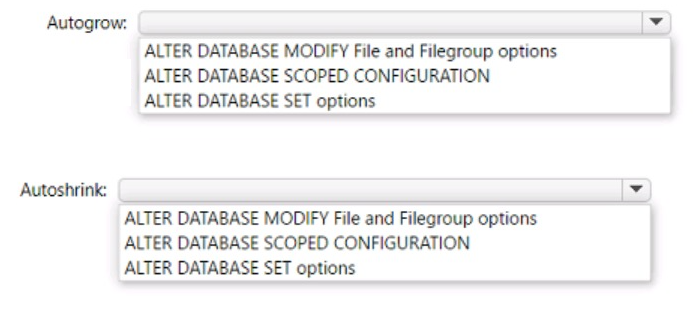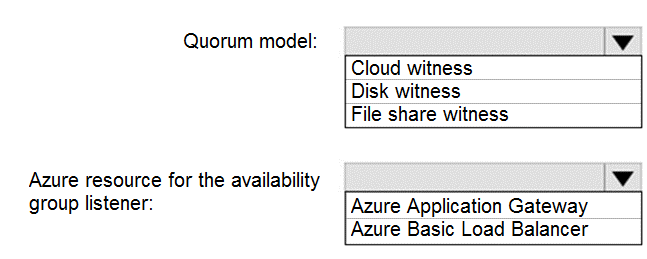Free Microsoft DP-300 Exam Dumps
Here you can find all the free questions related with Microsoft Administering Microsoft Azure SQL Solutions (DP-300) exam. You can also find on this page links to recently updated premium files with which you can practice for actual Microsoft Administering Microsoft Azure SQL Solutions Exam. These premium versions are provided as DP-300 exam practice tests, both as desktop software and browser based application, you can use whatever suits your style. Feel free to try the Administering Microsoft Azure SQL Solutions Exam premium files for free, Good luck with your Microsoft Administering Microsoft Azure SQL Solutions Exam.Hotspot
You have a SQL Server on Azure Virtual Machines instance that hosts a database named Db1.
You need to configure the autogrow and autoshrink settings for DB1.
Which statements should you use? To answer, select the appropriate options in the answer are
a.
NOTE: Each correct selection is worth one point.

https://learn.microsoft.com/en-us/troubleshoot/sql/admin/considerations-autogrow-autoshrink
Hotspot
You have a SQL Server on Azure Virtual Machines instance named VM1 that hosts a database named DB1. You run the following query.

For each of the following statements, select Yes if the statement is true. Otherwise, select No.

Hotspot
You have a SQL Server on Azure Virtual Machines instance that hosts a database named Db1.
You need to configure the autogrow and autoshrink settings for DB1.
Which statements should you use? To answer, select the appropriate options in the answer are
a.
NOTE: Each correct selection is worth one point.

MultipleChoice
D18912E1457D5D1DDCBD40AB3BF70D5D
You need to identify the cause of the performance issues on SalesSQLDb1.
Which two dynamic management views should you use? Each correct answer presents part of the solution.
NOTE: Each correct selection is worth one point.
OptionsHotspot
You need to recommend a configuration for ManufacturingSQLDb1 after the migration to Azure. The solution must meet the business requirements.
What should you include in the recommendation? To answer, select the appropriate options in the answer area.
NOTE: Each correct selection is worth one point.

Scenario: Business Requirements
Litware identifies business requirements include: meet an SLA of 99.99% availability for all Azure deployments.
Box 1: Cloud witness
If you have a Failover Cluster deployment, where all nodes can reach the internet (by extension of Azure), it is recommended that you configure a Cloud Witness as your quorum witness resource.
Box 2: Azure Basic Load Balancer
Microsoft guarantees that a Load Balanced Endpoint using Azure Standard Load Balancer, serving two or more Healthy Virtual Machine Instances, will be available 99.99% of the time.
Note: There are two main options for setting up your listener: external (public) or internal. The external (public) listener uses an internet facing load balancer and is associated with a public Virtual IP (VIP) that is accessible over the internet. An internal listener uses an internal load balancer and only supports clients within the same Virtual Network.
MultipleChoice
D18912E1457D5D1DDCBD40AB3BF70D5D
You need to implement authentication for ResearchDB1. The solution must meet the security and compliance requirements.
What should you run as part of the implementation?
OptionsMultipleChoice
D18912E1457D5D1DDCBD40AB3BF70D5D
What should you do after a failover of SalesSQLDb1 to ensure that the database remains accessible to SalesSQLDb1App1?
OptionsMultipleChoice
You have a Microsoft SQL Server 2019 instance in an on-premises datacenter. The instance contains a 4-TB database named DB1.
You plan to migrate DB1 to an Azure SQL Database managed instance.
What should you use to minimize downtime and data loss during the migration?
D18912E1457D5D1DDCBD40AB3BF70D5D
OptionsMultipleChoice
You have an Azure virtual machine named VM1 on a virtual network named VNet1. Outbound traffic from VM1 to the internet is blocked.
You have an Azure SQL database named SqlDb1 on a logical server named SqlSrv1.
You need to implement connectivity between VM1 and SqlDb1 to meet the following requirements:
Ensure that all traffic to the public endpoint of SqlSrv1 is blocked.
Minimize the possibility of VM1 exfiltrating data stored in SqlDb1.
D18912E1457D5D1DDCBD40AB3BF70D5D
What should you create on VNet1?
OptionsMultipleChoice
You deploy a database to an Azure SQL Database managed instance.
D18912E1457D5D1DDCBD40AB3BF70D5D
You need to prevent read queries from blocking queries that are trying to write to the database.
Which database option should set?
Options
